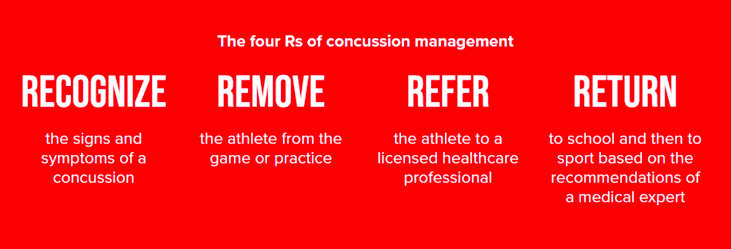Concussions
Racquetball Canada is committed to ensuring the safety of those participating in racquetball. Racquetball Canada recognizes the increased awareness of concussions and their long-term effects and believes that prevention of concussions is paramount to protecting the health and safety of participants.
The Racquetball Canada Concussion Policy provides guidance in identifying the common signs and symptoms of a concussion, protocol to be followed in the event of a possible concussion and knowledge of how to properly manage a concussion.
Racquetball Canada has a Concussion Code of Conduct to ensure all participants understand the risks associated with concussions that must be signed by all participants.
Concussions can occur while participating in racquetball. Since the circumstances under which a concussion can be sustained are so varied, it’s important for all coaches, parents, and athletes to be aware of the signs, symptoms, and what to do if a concussion occurs.

Concussion Training
Coaching Association of Canada Concussion Training
The Coaching Association of Canada has developed training designed to help coaches gain the knowledge and skills required to ensure the safety of their athletes. The Making Headway Concussion e-learning series are NCCP Professional Development modules that will make those who take the training concussion smart!
Coaches should expect to spend 60-90 minutes completing a module. Each completed module will be recorded on the NCCP coaching transcript as professional development credits.
Concussion Safety & Management
Canadian Guideline on Concussion in Sport
The Canadian Guideline on Concussion in Sport, produced by Parachute Canada is an important document for all stakeholders who interact with athletes in organized sports activity, including athletes, parents, coaches, officials, teachers, trainers and licensed healthcare professionals. Parachute is a leading Canadian charity dedicated to injury prevention.
Concussion Protocols
Concussions can occur while participating in any sport or recreational activity including racquetball.The following resources are aligned with the Canadian Guideline on Concussion in Sport and designed to teach how to ensure the safety of athletes and participants.It is important for coaches and clubs to use integrate these resources and protocols into their programs to protect the safety of all.
- Concussion Recognition Tool
- Player Concussion Code of Conduct
- Return to Sport Strategy
- Concussion Baseline Testing: Fact Sheet
Concussion Guides
CAC and Parachute have also produced a series of handouts for different audiences related to recognition and management that go hand in hand with concussion protocols. Click on the following links for downloadable information to share, post and distribute to those who participate in programs. The goal is participants at all levels to be aware of what to look for and what to do.
- Concussion Guidelines for Parents
- Concussion Guidelines for Coaches & Trainers
- Concussion Guidelines for Athletes
- Concussion Guidelines for Teachers
More Concussion Resources
Parachute Concussion Ed App
The Concussion Ed App is designed to give Canadians easy access to critical concussion resources. This free mobile app has been developed primarily for youth, parents and educators, but covers concussions throughout different scenarios for a wide audience. Click here for more information and to download the app.
Sport Information Research Council (SIRC) Concussion Toolkit
The Sport Information Research Council (SIRC) has provided tool-kit of excellent concussion awareness and prevention resources from many sport partners in Canada. SIRC invites to you download the resources or use as inspiration to make your own tools. Click here to link to the SIRC Concussion Toolkit.
CATT (Concussion Awareness Training Tool)
The Concussion Awareness Training Tool (CATT) is a series of online educational modules and resources with the goal of standardizing concussion recognition, diagnosis, treatment, and management. Some of these modules are geared to parents and coaches.
Other use CATT resources include:
Sport Information Resource Centre (SIRC) Headstrong Campaign
Parachute 2020 Public Awareness Campaign
Parachute, supported by the Public Health Agency of Canada, created a national awareness campaign for recognizing potential concussions. The following are to links to videos that can be shared on website and social media platforms.
- “Are you OK?” A public service announcement promoting concussion recognition and management.
- Olympian ice dance champion Scott Moir supports #CheckforConcussion
- World Downhill ski champion Steve Podborski supports #CheckforConcussion
